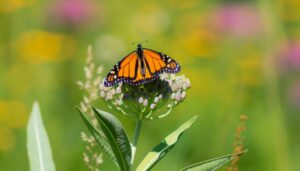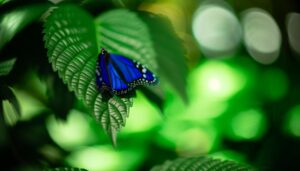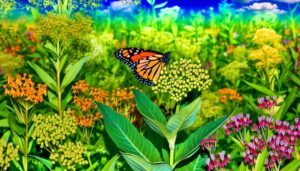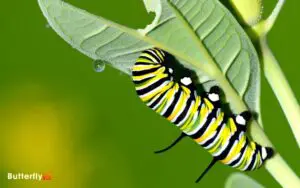Life Cycle of a Monarch Butterfly Diagram: Explore Helpful Guides!
You’ll witness the monarch butterfly’s life cycle through four distinct stages. The journey begins as eggs laid on milkweed leaves, which hatch in 3-5 days.
The emerging larvae, or caterpillars, go through five instars over about two weeks, feeding solely on milkweed and growing rapidly.
Next, the caterpillar forms a pupa within a chrysalis, transforming through a complex metamorphosis lasting around 10-14 days.
Finally, an adult butterfly emerges, ready for important activities like mating and migration. Each stage highlights vital biological processes and environmental interactions.
For an in-depth look at these metamorphic transformations, you’re in the right place.
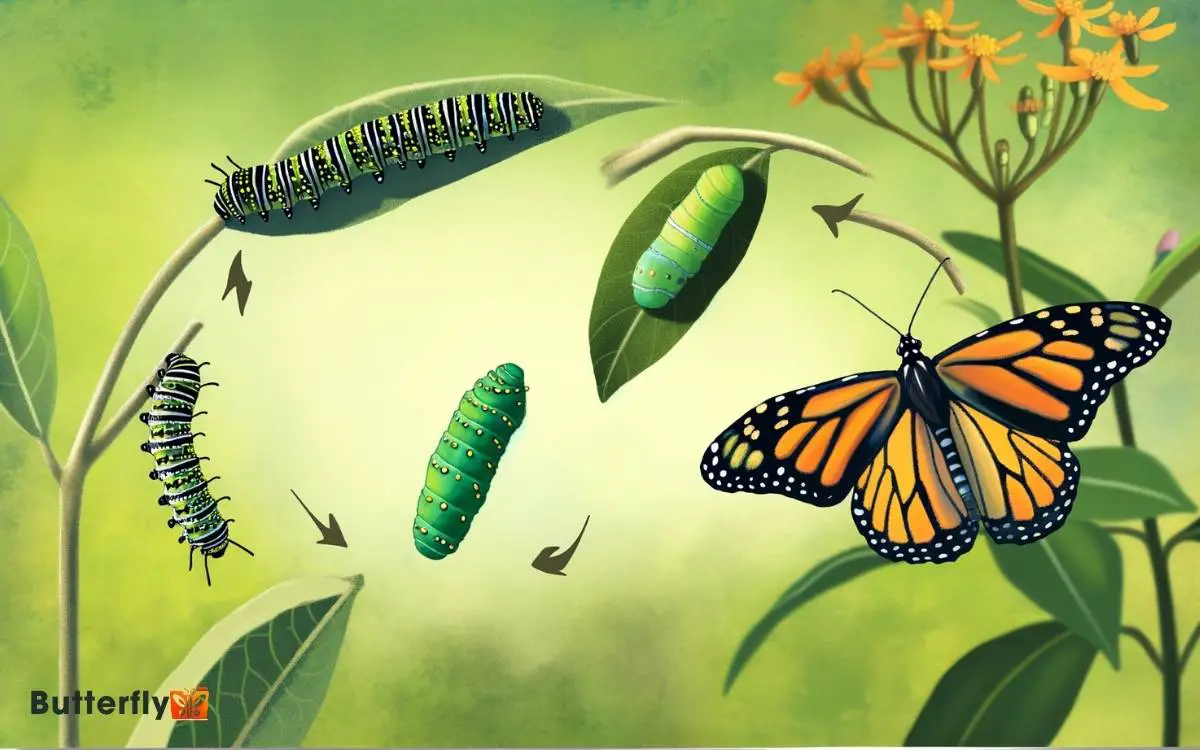
Key Takeaways
Overview of Monarch Butterfly
The Monarch butterfly, known scientifically as Danaus plexippus, is renowned for its vibrant orange and black wings and its remarkable migratory journey spanning thousands of miles.
You’ll find these butterflies inhabiting North America, migrating annually between Canada and Mexico. This journey is critical for their survival, as it allows them to escape cold climates and find breeding grounds.
Monarchs exhibit fascinating behaviors, such as clustering in large numbers during migration. They rely heavily on milkweed plants, which provide necessary nutrients and serve as a host for their larvae.
Understanding these butterflies’ complex life cycle and migration patterns offers insights into ecological balance and the impacts of environmental changes on species survival.
The Egg Stage
During the egg stage, female Monarch butterflies lay their eggs exclusively on milkweed plants, ensuring their larvae have immediate access to their primary food source upon hatching.
You’ll find these eggs, which are oval-shaped and about the size of a pinhead, attached to the undersides of milkweed leaves. They’ve a cream-white color and a slightly ridged surface.
Each female can lay hundreds of eggs over her lifespan, although she typically deposits only one egg per leaf to reduce competition among larvae.
The egg stage lasts about 3-5 days, depending on environmental conditions such as temperature and humidity. Monitoring these eggs closely can provide valuable insights into the early development stages of Monarch butterflies and their dependency on milkweed.
Egg to Larva Transformation
You’ll observe that the monarch butterfly lays its eggs on the underside of milkweed leaves, ensuring a food source for the emerging larvae.
Typically, the larva hatches in about four days, starting its journey by consuming the eggshell.
Early larva development is marked by rapid growth as it continuously feeds on milkweed, essential for its survival and future metamorphosis stages.
Egg Laying Process
Female monarch butterflies meticulously deposit their eggs on the underside of milkweed leaves, initiating the transformation from egg to larva.
Each egg, roughly the size of a pinhead, is oval and ribbed, ensuring it adheres securely to the leaf surface. You’ll notice that milkweed is vital as it serves as the primary food source for the emerging larvae.
The egg’s outer layer, or chorion, provides protection and contains nutrients essential for growth. Within a few days, embryonic development accelerates, driven by metabolic processes.
As the embryo matures, it prepares to hatch, signifying the next stage in the butterfly’s life cycle. Monitoring this stage closely reveals the intricate biological mechanisms that facilitate the monarch’s remarkable journey from egg to larva.
Larva Hatching Time
As the embryo reaches full maturity within the egg, it begins the process of hatching, revealing the larva that will start on its next phase of development.
The hatching process, also known as eclosion, involves the larva chewing its way out of the eggshell. The timing is vital; it typically occurs after 3 to 5 days, contingent on environmental factors like temperature and humidity.
Here’s a breakdown to visualize:
| Stage | Duration | Key Details |
|---|---|---|
| Egg Laid | Day 0 | Female deposits on milkweed |
| Embryo Development | Day 1-3 | Rapid cell division |
| Hatching Begins | Day 3-5 | Larva chews through eggshell |
| Larva Emergence | Day 3-5 | Fully emerged, ready to feed |
This phase marks the beginning of the monarch’s journey from egg to caterpillar.
Early Larva Development
Observing the early larva development reveals the mesmerizing change from egg to caterpillar, characterized by rapid growth and an insatiable appetite for milkweed.
Within just a few days after hatching, the tiny larva, or caterpillar, begins to consume the egg shell for its initial nutrients.
It then shifts to feeding on milkweed leaves, which provide the necessary toxins for the caterpillar’s defense mechanisms.
You’ll notice it molts several times, growing larger with each stage, known as instars. Each molt is critical, allowing the caterpillar to shed its exoskeleton and expand.
During this phase, efficient nutrient absorption and conversion into body mass are key processes. This period sets the foundation for the subsequent stages of metamorphosis.
The Larva Stage
In the larva stage, you’ll observe the monarch caterpillar undergo several molting phases, shedding its exoskeleton to accommodate rapid growth.
During this period, it primarily feeds on milkweed, which provides essential nutrients and toxins that protect it from predators.
Understanding these processes is vital to comprehending the monarch’s development and survival strategies.
Molting and Growth Process
How does the monarch caterpillar grow so rapidly during its larval stage?
It achieves this through a process called molting. As the caterpillar consumes food, its body expands, but its exoskeleton doesn’t stretch.
As a result, the caterpillar must shed its exoskeleton multiple times, a process known as ecdysis, to continue growing. Each stage between molts is called an instar. Monarch caterpillars typically go through five instars.
| Instar | Description |
|---|---|
| 1st | Tiny, black and white, about 2-6 mm |
| 2nd | Noticeable stripes, around 6-9 mm |
| 3rd | More distinct stripes, about 10-14 mm |
| 4th | Larger head, around 14-22 mm |
| 5th | Fully grown caterpillar, 25-45 mm |
Feeding Habits Explained
During its larval stage, the monarch caterpillar‘s rapid growth is fueled by its voracious feeding on milkweed leaves, which provide the essential nutrients required for its development.
You’ll notice that the caterpillar consumes almost constantly, as it needs to ingest large amounts of food to support its exponential growth.
Milkweed contains toxic compounds called cardenolides, which not only deter predators but also accumulate in the caterpillar’s body, offering a defense mechanism through its life stages.
As it molts several times during this phase, each instar, or growth stage, showcases an increase in both size and appetite.
This intense feeding continues until the caterpillar reaches its final instar, preparing for the transformative chrysalis stage.
Caterpillar Growth Process
Once the monarch butterfly egg hatches, the tiny caterpillar, known as a larva, immediately begins to feed on the milkweed leaves. This diet is vital as it provides the toxins that help protect the caterpillar from predators.
Over approximately two weeks, the caterpillar undergoes five distinct growth stages called instars. During each instar, it will shed its exoskeleton, a process known as molting.
You’ll notice the caterpillar increasing in size greatly, sometimes up to 2,000 times its original weight. The black, white, and yellow bands on its body become more pronounced with each stage.
Preparing for Pupation
As the caterpillar reaches the end of its fifth instar, it begins to search for a suitable location to form its chrysalis, signaling the start of the pupation phase. You’ll notice it moving to the underside of leaves, branches, or other sheltered spots.
The caterpillar uses its silk gland to spin a small silk pad, from which it hangs upside down in a ‘J’ shape. This position is critical for the transformation. The caterpillar’s body will contract, and its skin will split, revealing the chrysalis underneath.
During this stage, it’s crucial to make sure the caterpillar has a safe, undisturbed environment. Disturbances can cause stress, potentially affecting the formation of a healthy chrysalis and the successful shift to the next phase.
The Pupa Stage
The pupa stage, often referred to as the chrysalis phase, marks a period of significant transformation where the caterpillar’s body undergoes metamorphosis into an adult butterfly.
During this stage, the caterpillar forms a protective casing called a chrysalis. Inside, its body breaks down into a nutrient-rich soup, a process known as histolysis.
Specialized cells, called imaginal discs, then reorganize these nutrients, forming the structures of the butterfly. The chrysalis is usually green with gold flecks, offering camouflage against predators.
This stage lasts around 10-14 days, depending on environmental conditions. You’ll notice the chrysalis gradually darkening, signaling the nearing emergence of the adult butterfly.
Understanding the pupa stage is essential for appreciating the complexities of the butterfly’s life cycle.
Metamorphosis in Chrysalis
Within the chrysalis, metamorphosis is an intricate process where the caterpillar’s tissues are dismantled and restructured into the distinct features of an adult butterfly.
During this phase, enzymes break down the caterpillar’s tissues into a nutrient-rich soup. These nutrients are then used to form new structures such as wings, antennae, and other adult features.
Specific cells, known as imaginal discs, develop into the organs and body parts of the mature butterfly.
The transformation is meticulously controlled by hormones like ecdysone, which regulate the timing and progression of development.
This complex biochemical process guarantees that each structure is correctly formed and functional, preparing the butterfly for its next stage of life.
Emerging as a Butterfly
Upon completion of metamorphosis, the monarch butterfly carefully breaks free from the chrysalis, revealing its newly formed wings and vibrant colors.
You’ll observe the butterfly hanging upside down, allowing gravity to assist in expanding its wings. The wings, initially soft and crumpled, gradually unfurl and harden.
This process, called eclosion, is crucial for proper wing development. The butterfly will pump hemolymph, a blood-like fluid, through its veins to fully extend the wings.
During this time, the monarch is highly vulnerable to predators and environmental factors. It’s imperative that the wings dry completely to ensure they’re strong enough for flight.
This period of wing expansion and drying typically lasts a few hours before the butterfly is ready for its next stage.
The Adult Butterfly
As an adult monarch butterfly, you’ll engage in critical activities such as mating and reproduction, essential for the survival of the species.
Your feeding habits will primarily involve consuming nectar from flowers, which provides the necessary nutrition for your energy needs.
Additionally, you’ll participate in long-distance migration patterns, traveling thousands of miles to reach overwintering sites.
Mating and Reproduction
During the adult stage, monarch butterflies participate in a complex mating ritual that secures the continuation of their species.
Males chase females in a mesmerizing aerial dance. Once a mate is caught, they descend to the ground and the male transfers a spermatophore to the female, guaranteeing fertilization. This process promotes genetic diversity and species survival.
Consider the following key aspects:
- Aerial Chase: Males engage in vigorous flights to pursue females.
- Ground Coupling: The mating pair lands, where the male transfers sperm.
- Genetic Diversity: The exchange mixes genetic material, enhancing adaptability.
- Survival: Each union increases the likelihood of future generations thriving.
Understanding these steps helps you appreciate the intricacies of monarch reproduction.
Feeding and Nutrition
After the intricate mating ritual, adult monarch butterflies must sustain themselves through a specialized diet primarily consisting of nectar from a variety of flowering plants.
You’ll notice that monarchs use their proboscis, a tube-like tongue, to extract nectar. This nectar provides essential sugars for energy, fueling their daily activities and long-distance flights.
Additionally, they occasionally consume water and nutrients from sources like rotting fruit and tree sap.
Monarchs are particularly attracted to milkweed, as well as other nectar-rich flowers like lantana, zinnias, and goldenrods. Ensuring access to these plants is vital for their survival.
Migration Patterns
Each year, monarch butterflies undertake one of the most remarkable migration journeys in the animal kingdom, traveling thousands of miles from North America to the overwintering sites in central Mexico.
This journey isn’t just a feat of endurance but also a complex navigational challenge. You’ll find that monarchs use environmental cues such as the angle of the sun and the Earth’s magnetic field to guide them.
Throughout their migration, monarchs face significant obstacles:
- Extreme weather conditions – from scorching heat to freezing temperatures.
- Predation – birds, insects, and other threats.
- Habitat loss – due to deforestation and urban development.
- Lack of food sources – scarcity of nectar plants along the way.
Understanding these challenges underscores the resilience and determination of these incredible insects.
Conservation and Protection
To ensure the survival of monarch butterflies, it’s essential to comprehend and implement effective conservation strategies that address habitat loss, pesticide use, and climate change.
You should prioritize preserving native milkweed and nectar plants, which serve as important food sources and breeding grounds. Reducing the use of harmful pesticides can greatly improve their chances of survival.
Additionally, supporting policies that mitigate climate change will help maintain the environmental conditions necessary for their migration and reproduction.
You can also participate in citizen science projects that track monarch populations and migratory patterns. These data contribute to research efforts aimed at understanding and protecting these butterflies.
Conclusion
You’ve now seen the fascinating life cycle of a monarch butterfly, from a tiny egg to a vibrant adult. Like a meticulously orchestrated symphony, each stage plays a vital role in the butterfly’s development.
Understanding this process helps you appreciate the complexities of nature. By supporting conservation efforts, you can guarantee these extraordinary creatures continue to grace our world with their presence.
Your actions make a difference every butterfly begins with a single, protected egg.



